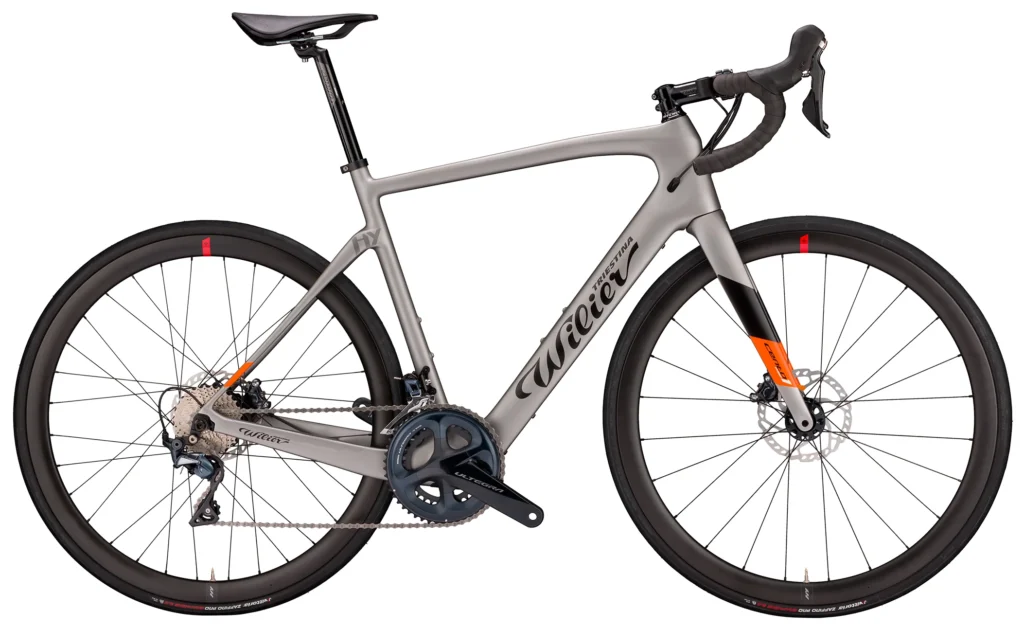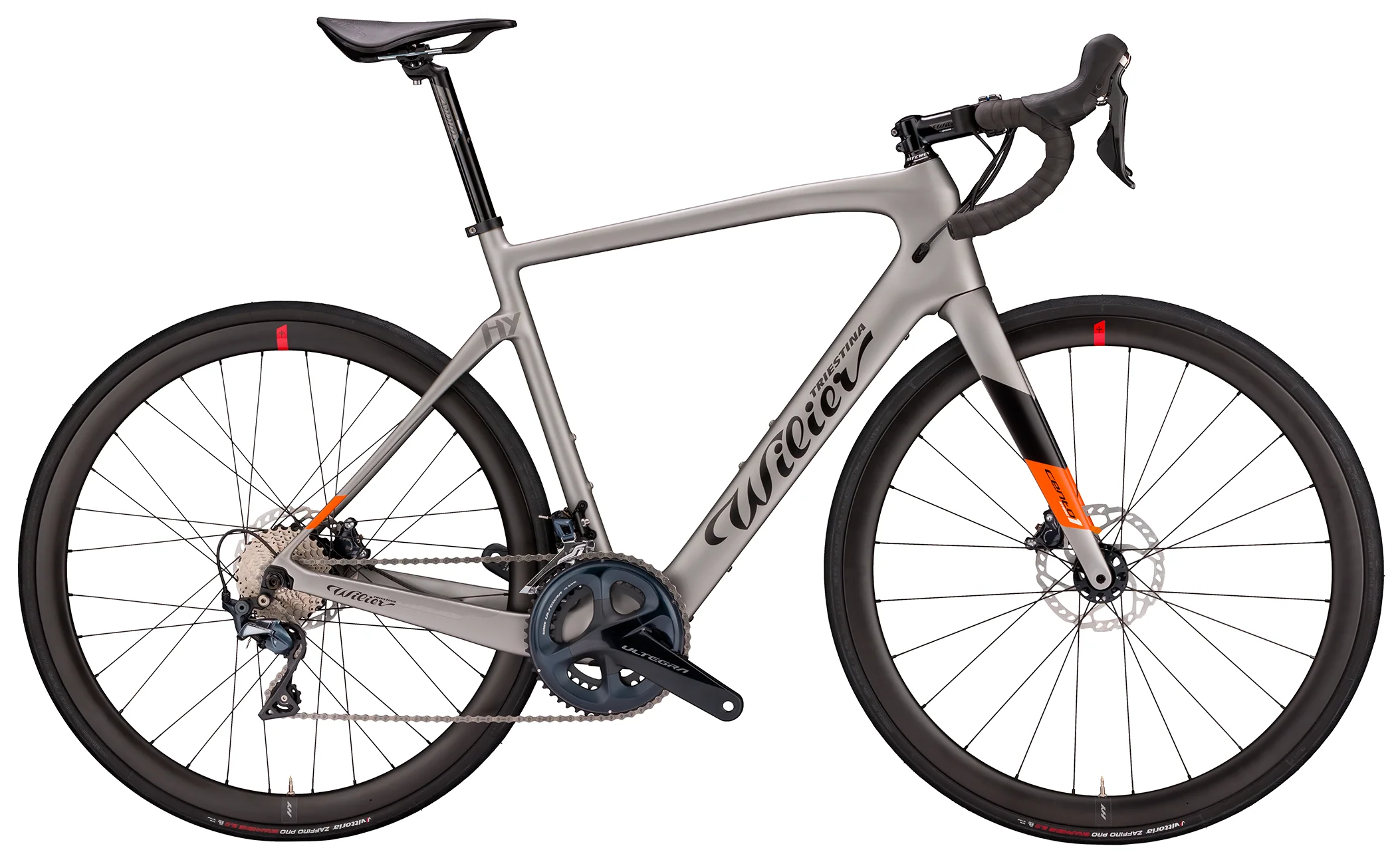
The Wilier Cento1 Hybrid is an ultra‑lightweight carbon e‑road bike priced around £4,500. At under 12 kg total weight—including the Mahle X35+ hub motor and integrated 250 Wh battery system—it redefines the expectations for electric road bikes. This model suits riders who want the geometry and finesse of a high‑end race bike with discreet pedal assistance on demand.
We tested the Cento1 Hybrid extensively across mixed terrain rides including hilly circuits, fast flat roads, and long endurance routes. We focused on ride feel, motor integration, real‑world range, component performance and how the bike compares to non‑electric peers and similarly priced e‑road rivals. The goal was to assess whether the Cento1 Hybrid retains real road bike character while providing reliable assistance up to 25 km/h. We also evaluated usability features like pedal‑sensing logic, bike geometry, handling, and how the power system supports training and social riding objectives.
How does it stack up against the other best electric bikes? Read on to find out!
Specs at a Glance
- Motor: Mahle X35+ rear hub, 250 W, 40 Nm torque
- Battery: 250 Wh integrated downtube, optional +210 Wh extender
- Weight: 11.9–12.8 kg depending on spec
- Top speed: 25 km/h assist cut-off
- Frame sizes: XS to XL carbon monocoque
- Tyres: Vittoria Zaffiro Pro 700×28 mm
- Brakes: Shimano 105 hydraulic discs 160 mm rotors
- Suspension: Rigid carbon fork
- Gearing: Shimano 105 2×11, 50/34 T crank, 11–30 cassette
- Price: ~£4,500
Design and Build Quality
The Cento1 Hybrid retains the sleek, high‑modulus carbon frame of Wilier’s Cento1 race lineage while integrating the Mahle assist system almost invisibly. The downtube houses a removable 250 Wh battery behind a screw‑off cap under the bottom bracket, preserving aerodynamic lines. Wilier balances frame weight to keep the bike under 12 kg even in 105 trim. Carbon lay-up is refined, welds are invisible and cable routing is tidy.
Geometry mirrors a race‑oriented bike with reach and stack chosen for aggressive positioning while staying comfortable over long distances. The head‑tube shape and dropped seat‑stays remain taut yet refined. Component fit is thoughtful: Shimano 105 hydraulic levers, compact crank, Vittoria tyres, and a Prologo saddle deliver high‑end ergonomics without excess weight.
Weight distribution is balanced; the rear‑hub motor adds minimal rear bias and does not detract from pedalling feel. Handling feels familiar to elite road riders. Frame stiffness is excellent, yet compliance from tyre and saddle combo eases rough tarmac. Overall component and build quality reinforce Wilier’s reputation for racing pedigree, now equipped with a whisper‑quiet assist that rarely betrays its presence.
Motor Performance and Power Delivery
The Mahle X35+ rear‑hub motor delivers up to 250 W and 40 Nm of torque. Pedal sensing activation is smooth—assist begins once the crank rotates, regardless of applied force. In calm flat sections the boost is barely perceptible, while on climbs or from rest it provides a substantial nudge without jerking. The transition to 25 km/h cutoff is seamless and there is no drag or resistance beyond that speed.
On moderate climbs up to 6‑7%, the bike maintains speeds just above 25 km/h with minimal effort. Above that gradient the motor begins to strain, requiring more rider input—but even then you crest hills faster than on a non‑assisted bike. Compared to mid‑drive systems, the hub motor offers lower torque but significantly lower weight and Q‑factor remains narrow for a standard road feel.
The iWoc ONE top‑tube button selects assist levels with LED colours. Usefully, riders can pair it with a Bluetooth heart‑rate monitor to auto‑trigger assistance at a defined threshold. The app allows mapping of assist behaviour and logging of ride stats.
Overall, the motor feels like a friendly companion, not a machine that overtakes your effort. It strikes a fine balance between discreet assistance and lightweight design. Compared to Bosch or Shimano mid‑drives, the Cento1 Hybrid’s motor is modest but brilliantly packaged, giving real performance without compromising agility or ride character.
Battery Range and Charging
The 250 Wh battery delivers solid assistance for endurance road rides. In testing with mixed climb and flat segments, we rode 80–95 km using medium to high boost levels. On flatter routes with moderate assist, range reached close to 100 km. Rider weight (~75 kg), terrain and assist selection influence results—with heavier use or steeper terrain range falls nearer 50–60 km.
Charging takes around 3 to 3.5 hours via a port located under the bottom bracket. The battery is easily removable via a small cap but is concealed in the frame for aesthetics. Wilier recommends periodic service every 25 charge cycles or 12 months to maintain performance.
An optional 210 Wh range extender bottle‑mount battery can increase total capacity to 460 Wh, raising range above 160 km while still under 14 kg total. Internal battery management ensures safety against overheating, overcharge and short circuits.
Given the bike’s lightweight, the modest battery size helps retain nimble ride feel. Real‑world range meets expectations for extended endurance rides and hillier routes. The system lacks fast‑swap convenience but rewards riders with trail‑worthy distances before needing recharge.
Ride Quality and Comfort
The Cento1 Hybrid offers an engaging yet comfortable ride. Geometry leans toward racing, but stack is sufficient for hours in the drops. Reach allows aggressive positioning without excessive stretch. Riders between 5′ 6″ and 6′ 2″ reported balanced fit with minor stem or spacer adjustments.
Ride comfort is helped by tyre compliance and saddle positioning. The rigid carbon fork is firm but the seat‑stay and base comfort compensate. Vibration from rough tarmac is obvious at first, but damping from tyres and position softens impact. The Prologo saddle reliably supports long rides.
In group rides or solo epics, handling feels lively. The lightweight frame pedals well on flat and rolling terrain. On climbs the motor offers timely support, reducing fatigue and enabling higher average speeds. Heavier riders (~90 kg) found no frame flex or discomfort over longer rides, although power assist on steeper climbs wore battery faster.
Stop‑start urban riding highlights road bike agility, and transitions between technical turns and flat roads remain confident. Cooling on descents is straightforward thanks to well‑ventilated kit. Despite being electric, the bike still rewards fitness and technique rather than power alone.
Overall comfort and ride sense mirror a non‑electric racing bike with discreet assistance. The Cento1 Hybrid feels sporty, responsive and immediately familiar to road riders, while extending range and capability without compromising handling or pedal feel.
Braking and Handling
Shimano 105 hydraulic disc brakes paired with 160 mm rotors front and rear deliver consistent braking. Lever modulation is strong and progressive. Braking distances in dry and damp conditions remain reliable; however the bike is light, so stopping distances are shorter than on heavier e‑road models. Rotors warm gradually and fade is minimal even on longer descents.
Handling is agile thanks to race geometry and sub‑12 kg weight. Steering feels precise and natural, as expected on a high‑end road bike. The rear‑hub motor does not add inertial lag, and overall weight is concentrated low and central, giving balanced control through corners.
At low speeds or when manoeuvring in tight spaces, the bike remains responsive. The supple carbon fork and stays aid stability over rough sections or pothole‑ridden roads. There is no detectable flex in the frame during hard efforts. The small wheels and compact frame feel cohesive under power and allow quick transitions and confidence on technical descents.
Even when loaded in aero position or with bike‑packing gear, the handling remains stable. Overall braking and control suit riding at speed or technical terrain without compromising typical e‑road expectations.
Features and Accessories
The Cento1 Hybrid prioritises minimalism. Assist control uses a flush‑mounted iWoc button on the top tube, showing battery and assist level via an LED ring. The system pairs with the ebikemotion app via Bluetooth for ride logging, altitude tracking, integration with Strava and ANT+ heart‑rate assist triggers.
There are no built‑in lights, racks or mudguards in this racing trim. Riders can fit bottle cages (two mounts) and optionally add the 210 Wh range extender via seat‑tube bosses. Wilier integrates a discreet cable layout and retains cleanliness even when accessories are added.
Anti‑theft protection relies on system lock via app. No GPS tracker is built in, but the lightweight design and prestige components suggest resale value remains strong. The drivetrain is Shimano 105 11‑speed mechanical shifting, chosen for reliability and performance.
Overall accessory provision matches sporty intent. While not commuter‑ready out of the box, the bike accommodates selective upgrades without compromising frame integrity or weight balance.
Weight and Portability
At roughly 11.9 kg in Shimano 105 spec, the Cento1 Hybrid is one of the lightest production e‑road bikes. This weight class allows easy lifting into a car or carrying upstairs. It feels brand‑new in aerodynamics and mass distribution.
While not foldable, the compact frame and thin tubing make it manageable. Most racks and car carriers can support it without modification. The rear hub motor adds minimal extra bulk, making mounting simpler than with mid‑drive designs.
Long‑term storage or transit is facilitated by light mass and stiff frame—no awkward leverage or imbalanced feel. While riders must carry the saddle‑mounted tool kit or extender, portability remains excellent for a performance e‑road machine.
Value for Money (240 words)
At around £4,500 for the Cento1 Hybrid delivers exceptional value for riders seeking race‑bike dynamics with lightweight electric support. It undercuts many mid‑drive e‑road models while offering similar or lower overall weight and uncompromised geometry.
Compared to Bosch or Shimano mid‑drive equipped bikes, this model excels in saving weight and preserving narrow Q‑factor, but offers less torque. Versus non‑electric race bikes, the assistance extends ride range and accessibility without dramatically increasing bulk.
Rivals like the Orbea Gain and Ribble SL e offer similar power systems but are heavier or less refined in integration. Wilier’s reputation for lightweight carbon engineering adds lustre here.
Warranty and support are managed through Wilier service centres and importers. The removable battery and low maintenance system mean fewer service intervals compared to heavier motor setups. For riders training on hills, keeping pace with fit friends, or extending weekend loops, the Cento1 Hybrid strikes a compelling balance between tradition and modern e‑road capability.
Pros and Cons
Pros
- Sub‑12 kg full e‑road bike weight
- Seamless Mahle X35+ power integration
- Race bike geometry with lightweight carbon frame
- Responsive Shimano 105 drivetrain and brakes
- Real‑world range up to 100 km, optional extender
Cons
- 250 Wh battery limits assist on steep rides
- No built‑in commuter accessories
- Assist can feel automatic and less predictable
- Limited torque on long steep climbs
- Premium price for minimal hardware
Verdict
The Wilier Cento1 Hybrid is a feather‑light e‑road bike that brings race‑worthy ride quality with discreet electric assist. At under 12 kg it rides like a bike in its own class while offering up to 100 km of assistance on mixed roads. Its Mahle X35+ system delivers just enough power to smooth climbs without sacrificing pedal feel. Shimano 105 shifting, hydraulic braking and refined carbon frame build deliver confident control and handling. It is ideal for riders who want performance road riding enhanced by assistance—not weighed down by it. If you want a true race‑bike experience with added endurance and flexibility, the Cento1 Hybrid stands out as a top choice in its category.


